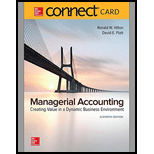
Concept explainers
Calculate the missing amounts and fill the amounts in the appropriate blanks.
Answer to Problem 37P
Calculate the missing amounts.
| Particulars | Division A | Division B | Division C |
| Sales revenue | $2,000,000 | $10,000,000 | $800,000 |
| Income | $400,000 | $ 2,000,000 | $200,000 |
| Average investment | $2,000,000 | $2,500,000 | $1,000,000 |
| Sales margin | 20% | 20% | 25% |
| Capital turnover | 1 | 4 | 0.8 |
| 20% | 80% | 20% | |
| Residual income | $240,000 | $1,800,000 | $120,000 |
Table (1)
Explanation of Solution
Working note (a):
Calculate the amount of sales margin for Division A.
Thus, the amount of sales margin for Division A is $2,000,000.
Working note (b):
Calculate the amount of capital turnover for Division A.
Thus, the amount of capital turnover for Division A is $2,000,000.
Working note (c):
Calculate the amount of return on investment (ROI) for Division A.
Thus, the return on investment for Division A is 20%.
Working note (d):
Calculate the amount of residual income for Division A.
Thus, the amount of residual income for Division A is $240,000.
Working note (e):
Calculate the amount of sales margin for Division B.
Thus, the sales margin for Division B is 20%.
Working note (f):
Calculate the amount of capital turnover for Division B.
Thus, the capital turnover for Division B is 4 times.
Working note (g):
Calculate the return on investment for Division B.
Thus, the return on investment for Division B is 80%.
Working note (h):
Calculate the amount of residual income for Division B.
Thus, the amount of residual income for Division B is $1,800,000.
Working note (i):
Calculate the capital turnover for Division C.
Thus, the capital turnover for Division C is 0.8.
Working note (j):
Calculate the total amount of invested capital for Division C.
Given: The Residual income is $120,000 and the required rate of return on invested capital is 8 percent.
The Return on Investment is 20%. So, calculate the amount of invested capital:
Thus, substituting the equations the invested capital is determined as follows:
Thus, the amount of invested capital for Division C is $100,000.
Working note (k):
Calculate the amount of income.
Thus, the amount of income for Division C is $200,000.
Working note (l):
Calculate the amount of sales revenue for Division C.
Thus, the amount of sales revenue for Division C is $800,000.
Want to see more full solutions like this?
Chapter 13 Solutions
Connect 1-Semester Access Card for Managerial Accounting: Creating Value in a Dynamic Business Environment (NEW!!)
- Cash Accounts Receivable Supplies Prepaid Insurance Equipment Notes Payable Accounts Payable The Lexington Group Unadjusted Trial Balance May 31, 2016 Debit Balances Credit Balances 20,350 37,000 1,100 200 171,175 36,000 26,000 Common Stock 50,000 Retained Earnings 94,150 Dividends 15,000 Fees Earned 429,850 Wages Expense 270,000 Rent Expense 63,000 Advertising Expense 25,200 Miscellaneous Expense 5,100 608,125 636,000arrow_forwardTrial Balance Rocky Mountain Tours Co. is a travel agency. The nine transactions recorded by Rocky Mountain Tours during June 20Y2, its first month of operations, are indicated in the following T accounts: Cash (1) 40,000 (2) 4,000 (7) 13,100 (3) 5,000 (4) 6,175 (6) 6,000 (9) 1,500 Equipment (3) 15,000 Dividends (9) 1,500 Accounts Receivable Accounts Payable Service Revenue (5) 20,500 (7) 13,100 (6) 6,000 (3) 10,000 (5) 20,500 Supplies (2) 4,000 (8) 2,200 Common Stock Operating Expenses (1) 40,000 (4) 6,175 (8) 2,200arrow_forwardQ1: Wyatt Company had three intangible assets at the end of 2024 (end of the fiscal year): Computer software and Web development technology purchased on January 1, 2024, for $70,000. The technology is expected to have a useful life of four years. A patent purchased from R. Jay on January 1, 2024 for a cash cost of $6,000. Jay had registered the patent with the Canadian Intellectual Property Office seven years earlier on January 1, 2017. The cost of the patent is amortized over its legal life. A trademark that was internally developed and registered with the Canadian government for $13,000 on November 1, 2023. Management decided that the trademark has an indefinite life. Required: 1. What is the acquisition cost of each intangible asset? tech 70k patent 6k trademark 13k 2. Compute the amortization of each intangible asset at December 31, 2024. The company does not use contra accounts. (Round the final answers to the nearest whole dollar.) tech 17.5k patent: ???? 3-a.…arrow_forward
 Cornerstones of Cost Management (Cornerstones Ser...AccountingISBN:9781305970663Author:Don R. Hansen, Maryanne M. MowenPublisher:Cengage LearningPrinciples of Accounting Volume 2AccountingISBN:9781947172609Author:OpenStaxPublisher:OpenStax College
Cornerstones of Cost Management (Cornerstones Ser...AccountingISBN:9781305970663Author:Don R. Hansen, Maryanne M. MowenPublisher:Cengage LearningPrinciples of Accounting Volume 2AccountingISBN:9781947172609Author:OpenStaxPublisher:OpenStax College Managerial AccountingAccountingISBN:9781337912020Author:Carl Warren, Ph.d. Cma William B. TaylerPublisher:South-Western College Pub
Managerial AccountingAccountingISBN:9781337912020Author:Carl Warren, Ph.d. Cma William B. TaylerPublisher:South-Western College Pub


